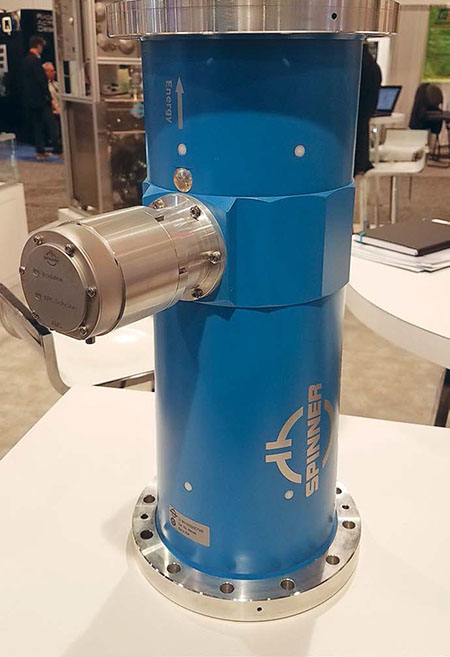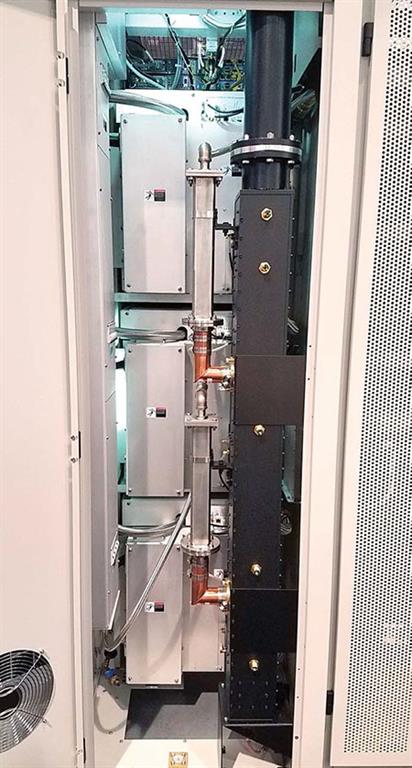Repack Work and ATSC 3.0 Dominate NAB Show
Broadcast TV antenna and transmitter manufacturers’ exhibits at the 2017 NAB Show were as packed as I’d seen since the DTV build-out a decade ago. One of the advantages of having these manufacturers in one place is that if one can’t deliver exactly what you are looking for, a short walk might reveal one that can. Here’s what I saw.
Broadcast engineers had a lot to look at and research. Most stations being moved to another channel as part of the FCC incentive auction repack will need a new antenna, a place to put it, and a new transmitter. Another antenna and transmitter may be needed to stay on the air while the main antenna is being replaced. Even stations that aren’t being repacked (including FM stations) may find they need an auxiliary antenna or site to stay on the air while work is being done on their primary site.
Although plans for a transition to ATSC 3.0 are still being formulated, smart engineers are making sure equipment they specify will work with ATSC 3.0.

Spinner AMS
ON THE SHOW FLOOR
Last year I described a product Spinner was showing that could detect arcs in antenna systems even when the arc occurred after multiple power dividers; but I was disappointed it wasn’t sized to work with the large line diameters used with high-power broadband antenna systems in the United States. Spinner recognized the demand and this year showed a version of its Antenna Monitoring System (AMS) that will work with line sizes up to 9 inches.
Spinner also had an item on display that they have been selling for many years, but which I hadn’t noticed. Their “Direct Access Unit” is a short piece of line permanently inserted in the transmission line at the top of the tower to allow an RF sweep of the line without the need to remove a section of line and install a test transition.
Considering the climbers, rigging and effort required to remove an elbow or section of large transmission line on the top of a tower, this device could pay for itself the first time a line has to be tested after the installation crew has left. The data sheet lists only 50 ohm units.

Fig. 1: The back of GatesAir Maxiva transmitter
GatesAir showed an updated version of its Maxiva solid-state transmitter that should make it easier to install and service. Fig. 1 shows the back of the transmitter.
Comark’s PARALLAX transmitter, which was still in prototype phase at last year’s NAB Show is now a finished product ready to ship. Both companies said they are offering low-VHF (Channels 2–6) versions of their transmitters for those stations that swapped out their high-VHF or UHF channels for low-VHF channels and cash.
Continental Electronics showed high-power UHF solid-state transmitter using Toshiba Gallium-Nitride power FETs in Doherty configuration. I’m not aware of other broadcast manufacturers using this device, at least in the United States, so it will be interesting to see how it performs.
The repack will be keeping antenna manufacturers busy for the next three years. While it’s likely most of the antennas will be similar to these they are replacing (probably a slot antenna), especially when directional patterns are required, I’ve seen more interest in broadband antennas capable of operating over several UHF channels.
Panel antennas, which I’ve covered before, are the most common broadband antenna, but broadband pylon designs, such as the cavity-backed slot, have been attracting attention due to lower windload and less complicated installation than panel antennas.
New this year was the Dielectric TFUGTH-BB pylon with a bandwidth of 60 MHz (10 channels). It is designed as a topmount antenna, compared with the full UHF band sidemount TFU-WB series introduced last year. Both antennas have sufficient input power handling to support multiple stations on one antenna.
Alive Telecom joined Dielectric and RFS to offer a cavity-backed slot antenna, the ATC-BCSE. While Dielectric and RFS have focused on making a standard antenna product that can be manufactured and ready for delivery on short notice, Alive offered a wider variety of pattern options and a nice, smooth elevation pattern. They had a model of the antenna on display at the NAB Show. When evaluating any of these broadband antennas with directional patterns, be sure to get a pattern for each of the channels on which they will be used. Patterns may vary from channel to channel!
ATSC 3.0
ATSC 3.0 is on the air now in Korea. Sinclair has an ATSC 3.0 experimental SFN operating in the D.C.-Baltimore area, and WRAL has an ATSC 3.0 experimental station on in Raleigh, N.C. Pete Socket, director of engineering and operations, described the construction of the station at WRAL in a presentation at ERI’s NAB Show breakfast.
While all the pieces of the ATSC 3.0 standard have not been finalized, a broadcaster could find all the components needed to put an ATSC 3.0 signal on the air from manufacturers at the NAB Show, as proved by the ATSC 3.0 broadcasts in Las Vegas.
Both the Comark and GatesAir transmitters include exciters with firmware, which can be switched to ATSC 3.0 with a license key. Rohde and Schwarz offered a software-defined modulator add-on to its current THU9 exciter that allows switching to ATSC 3.0. The Teamcast and Pro-Television exciters support ATSC 3.0 and can work with many new and existing transmitters. Enensys (which announced its acquisition of Teamcast at the show), Unisoft and Triveni showed packages broadcasters could assemble to begin broadcasting ATSC 3.0.
Receivers were harder to find this year. NAB showed the gateway it developed under its Pilot program. Avateq and Triveni joined forces to provide a device that provides full RF analysis of the ATSC 3.0 signal as well as analysis of ATSC 3.0 tables and data structure. DekTec’s DTA-2131 and Atsc3Xpert software-defined receiver was used in a number of the demos at the show. I heard comments about additional ATSC 3.0 test receivers becoming available, some based on a later version of the LG LGDT3307A demodulator chip LG showed last year, but no release dates or public announcements.
ATSC 3.0 offers capability far beyond that of ATSC 1.0 and it would be a shame to squander all the work that went into ATSC 3.0 by limiting it to replication of the same linear programmed, “single stick” ATSC 1.0-style broadcasts. Sinclair Broadcast Group has a plan for fully exploiting the capability of ATSC 3.0, which Louis Libin presented at show.
The plan builds on stations sharing spectrum and bandwidth and dynamically changing transmission characteristics as business demands—targeting different devices, users and services throughout the day and week. Universal coverage is assumed, which means multiple transmitters—an SFN—is required. Different spots can run on different transmitters in an SFN for targeted advertising. Broadcasters pool spectrum and data and are assigned broadcast “packets” to meet their needs. These “packets” could be on VHF or UHF or even split over multiple stations. “Packets” is in quotes because I’m not referring to IP packets alone, but the frequency and modulation over which these packets are carried. This is a different approach to broadcasting—a completely different universe. To better understand it, visit http://sbgi.net/one-media/ and start with the 2017 NAB Vision Paper available from that web page.
Next month I’ll consider repack antenna options—specifically the benefits of using elliptical or circular polarization. Recent tests with a full CP signal from the new antenna at One World Trade Center showed some interesting results.
If there are topics you would like me to cover or items I’ve missed, email me atdlung@transmitter.com.
To follow our online coverage, visit our repack silo, www.tvtechnology.com/repack.
Get the TV Tech Newsletter
The professional video industry's #1 source for news, trends and product and tech information. Sign up below.

Doug Lung is one of America's foremost authorities on broadcast RF technology. As vice president of Broadcast Technology for NBCUniversal Local, H. Douglas Lung leads NBC and Telemundo-owned stations’ RF and transmission affairs, including microwave, radars, satellite uplinks, and FCC technical filings. Beginning his career in 1976 at KSCI in Los Angeles, Lung has nearly 50 years of experience in broadcast television engineering. Beginning in 1985, he led the engineering department for what was to become the Telemundo network and station group, assisting in the design, construction and installation of the company’s broadcast and cable facilities. Other projects include work on the launch of Hawaii’s first UHF TV station, the rollout and testing of the ATSC mobile-handheld standard, and software development related to the incentive auction TV spectrum repack. A longtime columnist for TV Technology, Doug is also a regular contributor to IEEE Broadcast Technology. He is the recipient of the 2023 NAB Television Engineering Award. He also received a Tech Leadership Award from TV Tech publisher Future plc in 2021 and is a member of the IEEE Broadcast Technology Society and the Society of Broadcast Engineers.
